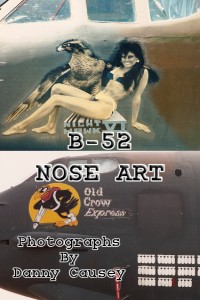Danny Causey parked his vehicle at the end of a row of B-52s, put on his sunglasses and pulled on his cap to shield his eyes from the relentless Arizona sun. He walked down endless rows of aircraft, the only sounds the gravel and scrub crunching under his work boots, maybe the scurry of a rabbit, the creaking of massive elevators and rudders in the hot desert wind and the occasional roar of a jet from nearby Davis Monthan Air Force Base. These are the acts of someone who loves aircraft, who has that special affinity for the hardware, and the men who flew them. For most of the aircraft, this was their last landing, the last stop in storied histories. They would be cannibalized for spare parts, or cut up and reclaimed for their metals. A special few might find refuge in museums or displays. And one lone man would walk their ranks, photograph them and bid them a last goodbye. That’s how this book came to be. These are the B-52 nose art photographs of Danny Causey. B-52 Nose Art contains over sixty photographs of B-52 aircraft as they made their last journey. Also available is Denizens of the Desert (ISBN: 978-1-934446-15-7), a full-color print book containing these photographs and more, including KC-135, A-10, F-111 and other aircraft.

Excerpt 1:
Preface
Late in 2007 I was going through boxes of family photos. My goal was to find pictures I could use to fill a small digital photo frame as a Christmas present for my father. While searching for pictures of my late younger brother, I came across several photo albums filled with aircraft pictures. This was not a complete surprise, as photography and aviation have been recurrent themes between my father, brother and me.
My father had followed a life-long passion of photography and aviation, working as a portrait photographer, news photographer and photographing air shows, all while enjoying a long aviation-related career in the government.
I served in the United States Air Force, Strategic Air Command, and attended my share of air shows and took innumerable pictures of aircraft over the years.
But it was the albums of pictures taken by my late brother that caught my attention. Danny served in the Navy, on the carrier USS Midway, and later worked at the United States Air Force Aerospace Maintenance And Regeneration Center (AMARC, don’t call it ‘The Boneyard’), at Tucson, Arizona. He sadly passed away, too young, from complications due to Diabetes.
I’d collected several boxes of his effects and moved them to our home in Ohio when my wife and I moved my father to be near us. Among these boxes I came upon several albums of photos he’d taken while working at AMARC. As the aircraft came to AMARC, for many it was their last destination, somewhat sad endings to what had been glorious careers in defense of the United States. The great majority of Danny’s pictures were of the nose art, those wonderful paintings of seductive ladies, fearsome warriors, cartoon characters and tributes to states or cities.
Many of the aircraft carried close connections to me. As a Doppler Radar Technician (AFSC 32854) I worked on B-52 D/F/G/H aircraft and also KC-135s while assigned to the 93rd Bomb Wing. Later, as an employee at McClellan AFB and while serving in the Reserve 406th Combat Logistics Support Squadron, I spent weekends working on FB-111 and A-10 aircraft. It was easy for me to turn the pages of the photo albums and think back to the times I climbed in the wheel well of a B-52 to change out a Receiver-Transmitter or Frequency Tracker.
I also imagined Danny, parking his vehicle at the end of a row of B-52s, putting on his sunglasses and pulling on his cap to shield his eyes from the relentless Arizona sun. He would walk down endless rows of aircraft, the only sounds the gravel and scrub crunching under his work boots, maybe the scurry of a rabbit, the creaking of massive elevators and rudders in the hot desert wind and the occasional roar of a jet from nearby Davis Monthan Air Force Base. These are the acts of someone who loves aircraft, who has that special affinity for the hardware, its history, their stories and the men who flew them.
For most of the aircraft, this was their last landing, their last stop in storied histories. They would be cannibalized for spare parts, or cut up and reclaimed for their metals. A special few might find refuge in museums or displays. And one lone man would walk their ranks, photograph them and bid them a last goodbye.
That’s how this book came to be. These are the B-52 nose art photographs of Danny Causey.
Gregory Causey
Ohio 2008
Excerpt 2:
INTRODUCTION
Ace in the Hole, Brute Force, City Of Merced, Grim Reaper, Hoosier Hot Shot, Night Stalker, beautiful women, fearsome warriors, tributes to locations and cartoon characters abound in the following pages.
Images painted on aircraft go back to the earliest days of military aviation, World War I. Famed German ace Werner Voss took advantage of the cooling holes to paint a face on the cowling of his Fokker DRI. French ace Charles Nungesser had a morbid rendition of death, replete with coffin and skull and crossbones, painted on his Nieuport.
While the painting of images began in WWI it certainly reached its zenith in the next major conflict, WWII.
The famous shark-mouthed P-40s of the American Volunteer Group (AVG), the Flying Tigers of WWII, achieved iconic status and the shark mouth motif continues to be popular to this day. It should be noted that German aviators were using the shark mouth as early as WWI.
I suppose the question that begs asking at this point is…why? Why do aviators and ground crews adorn their aircraft with these images? Perhaps it’s rooted in psychology: some need to belong with the machine, ‘to name it is to claim it.’ There is certainly precedence in the reference of ships in the feminine gender, a tendency to anthropomorphize those objects that so closely link to our own destinies.
Or it could be attempts by those far from home, facing perilous circumstances, to provide some semblance of home, to remind them what they’re fighting for.
Certainly there are morale aspects, raising one’s own warrior instincts or conversely, trying to strike fear in the hearts of the enemy.
I would posit the theory that it is any combination of reasons. Each image evokes its own response, from humorous, to naughty, to ferocious.
Unfortunately, during my time in uniform, such decorations were out of vogue, the victims of political correctness and a different mood about the nature of the military. Certainly I knew about such, having built the requisite model airplanes as a child, reading aviation books and visiting museums, where I saw real nose art.
Like many things in life, art on aircraft came back into vogue. And from what I’ve seen, the new practitioners of the art have one foot firmly planted in their illustrious heritage while stepping out boldly with the other.
The photographs on the following pages are from aircraft from the modern era. The artists, all certainly too young to have been around in that heyday of glorious nose art, have nonetheless captured the spirit, and a glorious tradition lives on.
Many of these artworks were cut from the aircraft and put on display at the Cold War Gallery of the National Museum of the United States Air Force at Wright-Patterson AFB, Ohio.
I’ve seen these works of art there, and I’m glad that they were preserved. But I prefer my brother’s photographs. Perhaps it’s a familial bias, but for me, his photographs put the work in context. The image of the nose art on a bomber, perhaps with the sight of others in the background, bits of spraylat peeling off, or a fairing open, perhaps to remove some piece so that a B-52H may soldier on, to me that evokes more response than a piece of metal cut out and put on display.
Please enjoy modern day aircraft nose art photographed by Danny Causey.

